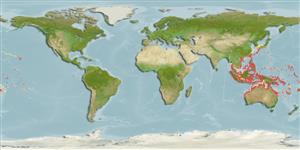Common names from other countries
Environment: milieu / climate zone / depth range / distribution range
Ecologia
marinhas associadas(os) a recifes; intervalo de profundidade 0 - 30 m (Ref. 86942). Tropical; 38°N - 26°S, 96°E - 148°W
Indo-Pacific: Myanmar to the Society Islands.
Tamanho / Peso / Idade
Maturity: Lm ? range ? - ? cm
Max length : 115 cm TL macho/indeterminado; (Ref. 90102)
Descrição suscinta
Chaves de identificação | Morfologia | Morfometria
Vértebras: 155 - 157. Body pale, almost white, with dark snout (Ref. 48635) and distinctive marking on back of head.
Inhabits muddy to sandy inshore areas and occasionally forages in the open at night (Ref. 637). Burrowing species (Ref. 75154). Caught rarely with gill net from the muddy shallow bottoms of Ryukyu Islands (Ref. 637). Nocturnally active (Ref 90102).
Ciclo de vida ou comportamento de acasalamento
Maturities | Reprodução | Spawnings | Egg(s) | Fecundities | Larvas
Myers, R.F., 1991. Micronesian reef fishes. Second Ed. Coral Graphics, Barrigada, Guam. 298 p. (Ref. 1602)
Status na Lista Vermelha da UICN (Ref. 130435)
CITES (Ref. 128078)
Not Evaluated
Ameaça para os humanos
Harmless
Uso pelos humanos
Pescarias: sem interesse
Ferramentas
Can't connect to MySQL database fbquizv2. Errorcode: Too many connections
